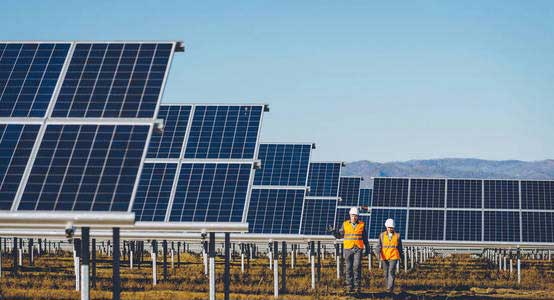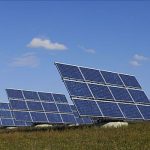
How To Build A Solar Power Station Ⅲ
4. Combiner box design and installation
Large and medium-sized grid-connected photovoltaic power plants usually choose two specifications of combiner boxes according to the arrangement of the array, namely 12 in 1 out and 16 in 1 out or two specifications matched. When designing, priority should be given to those with many circuits. The combiner box should have the function of cutting off the fault current, the inlet side adopts photovoltaic special DC fuse protection, the outlet side generally adopts DC low-voltage molded case switch protection, and the outlet side is not recommended to use fuse protection. The combiner box should be equipped with a special surge protector for photovoltaics, and the positive and negative poles should have lightning protection functions. The combiner box should be equipped with a monitoring device with a communication interface, which can monitor and upload the DC current, total output current, bus voltage and total output power of each incoming branch in real time, the status of the fuse and DC low-voltage molded case switch of each branch, and the abnormal alarm light of each incoming branch.
The combiner box should be easy to fix and install, generally mounted on the system bracket, and the installation height of the bottom of the box should meet the requirements of each restriction. The installation position of the combiner box inlet and outlet line and the bottom of the box should leave enough installation space, which should be convenient for construction and ensure the installation quality.
Each branch of the combiner box enters the line, and anti-reflective diodes are installed to improve the operating safety factor, but a certain amount of power generation will be lost. The design should comprehensively consider whether to install anti-reflective diodes according to the power station construction environment and methods. If the power station is built in a place with high humidity and strong corrosion, or when the DC cable is directly buried, it is recommended to install it in order to ensure safe operation; If the construction environment of the power station is good, when the DC cable is laid along the bridge, it is recommended not to install it in order to pursue higher power generation; The installation of anti-reflective diodes increases its own failure points, and it is not recommended to install them in places with high ambient temperatures.
Combiner boxes are installed at various locations in the power station, and the protection level should be designed according to the local climatic conditions. For example, in places with high humidity (such as complementary fishing and light), the moisture-proof level should be increased accordingly; Places with high temperatures (such as agricultural light complementarity, agricultural greenhouses) should strengthen the heat dissipation function; Corrosive places (e.g. along the beach) shell
Materials such as stainless steel or alloys should be used.
5. Inverter design selection and installation
The inverter is a converter device that converts DC electric energy into AC power and is an important component in the photovoltaic power station system. For large and medium-sized grid-connected photovoltaic power station projects, large-capacity centralized grid-connected inverters are generally selected. Generally, the larger the capacity of a single inverter, the relatively low unit manufacturing price and the higher the conversion efficiency. Choosing a single inverter with large capacity can reduce investment in Chengdu and improve system reliability. The higher the inverter conversion efficiency, the higher the efficiency of the photovoltaic power generation system, and the smaller the loss of the total power generation of the system. Therefore, when the rated capacity is the same, an inverter with high conversion efficiency should be selected. The DC input range of the inverter should be wide, and it should have certain anti-interference ability, environmental adaptability, and instantaneous overload ability when the solar radiation is low in the morning and evening. If there is a certain degree of overvoltage, the photovoltaic power generation system should be able to operate normally; In the event of a fault, the inverter must be automatically delisted from the main grid. After the system disturbance, the inverter is not allowed to be connected to the grid until the grid voltage and frequency return to normal, and it can be automatically reconnected after the system voltage and frequency return to normal. According to the requirements of the power grid for the operation mode of photovoltaic power plants, the inverter should have AC overvoltage, undervoltage protection, overclocking, underfrequency protection, anti-island protection, AC and DC overcurrent protection, overload protection, high temperature protection and other functions. The inverter should have multiple communication interfaces for data acquisition and send to the control room.
In order to reduce the use of DC cables and reduce DC loss, the inverter should be arranged in the middle of each sub-array as much as possible. However, the sub-arrays of the “fishery-solar complementary” photovoltaic power station are built in fish ponds or lotus ponds, and the installation of the inverter in place and operation and maintenance are extremely inconvenient, so the “fishery-solar complementary” type power station inverter should be arranged on both sides of the road in the station, and even so, it should be as close as possible to each sub-array. Therefore, the organic combination of road, inverter and combiner box should be considered before the overall layout of the power station. Rooftop PV power inverters are generally designed to be ground-mounted or installed directly in the underground space of the building.
For photovoltaic arrays using automatic tracking system, due to the large area and the distance between each bracket system, the DC cable consumption and DC loss of the installed centralized inverter will be relatively large, and the string type small-capacity inverter can be selected.
At present, the installation of many domestic inverter inlet and outlet lines is quite inconvenient, which brings great difficulty to installation and leaves certain safety and quality hazards. Generally, it is stipulated that the installation position of the inlet and outlet line and the bottom of the box should leave an installation space of ≥250mm.
To be continued…





